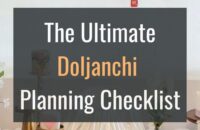Hahm is the quirky pre-wedding party you didn’t know you needed!
I’ll explain:
- definition of hahm
- reason for hahm ceremonies
- what’s inside a hahm box!

Key Takeaways
- Hahm means box and refers to a fun ceremony of gift giving from the groom’s family to the bride’s side before the wedding.
- Hahm is nostalgia for Koreans, but some still practice it.
- Hahmjinabi, an equivalent of a best man, carries the hahm box on his back and wears a dried squid as a mask.
What is hahm (함) in Korea?
Hahm (함) by itself just means box. You can add hahm at the end of a Korean word to say “something box” like “보석함” or “jewelry box”.
When it comes to Korean wedding traditions, hahm is a fun ceremony of gift giving from the groom’s family to the bride’s side before the wedding.
Why do Koreans have a hahm ceremony?
Hahm is for sending gifts to loved ones, showing affection and promising marriage.
Hahm ceremony is also used to announce the marriage to neighbors and celebrate together.

Who is hahmjinabi (함진아비)?
The groom’s relative or close friend becomes “hahm-jin-a-bi (함진아비)“. It’s the equivalent of a best man in western wedding ceremonies.
He carries the hahm box on his back and wears a dried squid as a mask. It seems frightening, but it’s loads of fun!
Only a happily married man can traditionally become hahmjinabi.
Why do Koreans wear a squid mask for hahm?
Hahmjinabi wears a dried squid mask, but he can substitute it by painting charcoal on his face. This might be problematic outside of Korea as you can imagine.
They wear a dried squid mask in order to:
- get as much attention as possible to maximize the celebration
- cast out evil spirits as a shamanistic symbol
- look funny to break the tension of organizing a wedding and put everyone at ease.

How does a hahm ceremony work?

You can get a better idea by watching this scene from The Gentlemen of Wolgyesu Tailor Shop.
- A group of the groom’s male relatives or friends participate in this ceremony.
- The group arrives at the bride’s home around sunset in the evening.
- Upon sunset when yin and yang changes, the group holds cheongsachorong (청사초롱 or traditional Korean lantern with a red-and-blue silk shade) and enters the village (nowadays, the apartment), starting a party.
- The bride’s family greet them and offer food/drinks to pay for hahm.
- The group, of course, refuses to enter.
- The bride’s family lay down a trail of cash in envelopes to lure the men to their house.
Sometimes, the bride’s pretty friends seduce them into the house. - The group keeps chanting “hahm for sale or buy hahm (함 사시오 or 함 사세요!)”. This was how neighbors used to hear the news about a marriage before Instagram. (The bride’s family used to treat the neighbors to food and drinks, so the wealthy could afford the longer version of this tradition.)
- Once hahmjinabi enters the bride’s home, he steps on and breaks a dry hard gourd bowl (박) to get rid of unclean spirits at the doorstep.
- Then, everyone gets food and drinks, resulting in a fun party.
When does a hahm ceremony happen?
Hahm is usually sent from one month to one week before the wedding.
Evenings on the weekend are recommended when everyone’s at home.
What’s inside the hahm box?
Gifts galore! The top five are considered essential, and the rest are up to you:
- Honseoji (혼서지): A letter to show gratitude to the wife’s parents for allowing the marriage
- Sajudanja (사주단자): The bridegroom’s four pillars of destiny (groom’s birth year, date and time) written on a paper, according to Korean astrology
- Osaek Jumeoni (오색주머니): Five-colored pockets, including a pink pocket containing cotton seeds for family prosperity; red pocket containing red beans to chase away evil spirits; yellow pocket containing yellow beans symbolizing precious status; blue pocket containing glutinous rice for the newlywed couple to be patient and last a hundred years; and green pocket containing sorghum symbolizing the purity of the bride.
- A pair of mandarin ducks (원앙 한쌍): When marriage counseling isn’t working. A Korean wedding duck lets you send a signal to the spouse after an argument by turning the head in the opposite direction to say, “let’s make up”.
- Cash in an envelope
- Jewelry
- Formal wear
- Purse: Usually, Louis Vuitton, Chanel or YSL bag
- Mirror (거울): Korean jewelry box with mirror to illuminate the future of the couple
Now, some are modernizing “hahm box” with a “suitcase”, so the couple can use it on their honeymoon.
Do Koreans still practice hahm tradition?
Hahm ceremony was common until the 80s-90s. However, this custom almost disappeared.
It started to get a bad image due to incidents with hahmjinabi who went too far running amok and breaking off the marriage.
Logistically, it’s difficult to chant “hahm for sale” in apartments or cities with high population density. You might have to invite the police to your party too.
In the old days, weddings used to be a village festival, and no one complained about noise from hahm ceremonies. The overall vibe was to be festive and congratulate the family. Now, Koreans don’t really know their neighbors and are very sensitive to noise.
People do it on the down low and quietly bring the hahm box.
Subscribe for
exclusive info on Korea
Did we miss anything?
Let us know your thoughts or questions about hahm in the comments!




Wow, I never heard about Hahm before reading this. Super interesting!
Thanks Jasmine! Hahm is a fun and unique part of Korean culture. 🙂